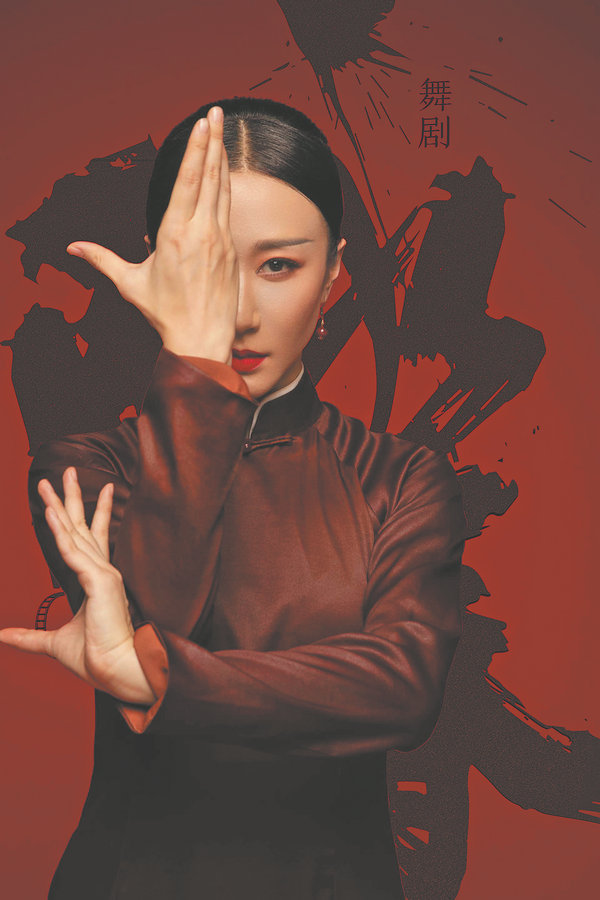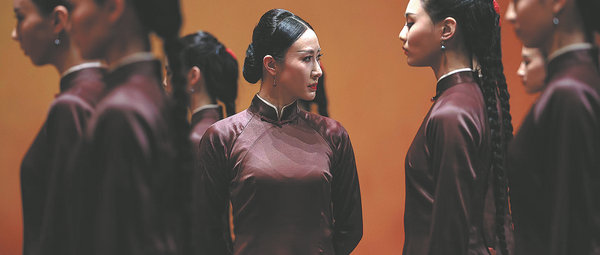

Her hair is neatly pulled back. Her eyes are sharp and firm. Her movements are full of power and strength. Her fists and palms change rapidly between defense and attack.
When Zhang Yashu performed the four-minute dance piece, Wing Chun, during China Central Television's Spring Festival Gala — one of the most-watched TV shows in China, which aired on Lunar New Year's Eve — the dancer, clad in a deep red costume, attracted many fans with her performance.
They were deeply impressed by the dance piece, which showcased the essence of kung fu. They also gave Zhang heartfelt applause for her kung fu techniques.
"She is both cool and graceful. I want to learn kung fu after watching the dance piece," one viewer wrote on Sina Weibo.
"Unlike many other roles the female dancers performed in the gala, such as goddesses, who are sweet, delicate and angelic, the female kung fu artist that Zhang played is so different. She is beautiful in a way which is rarely presented onstage," wrote another viewer.
"I read those reviews the day after the gala, which made me very proud. I am glad that people see different sides of women that cannot be limited to certain stereotypes," says Zhang.

The dance was inspired by the dance drama, Wing Chun, which premiered in Shenzhen, Guangdong province, in December 2022.It has toured nationwide with more than 140 shows so far.
"When we prepared the dance for the TV gala, we practiced our eye expressions. With a dozen female dancers standing in front of mirrors, we trained together," Zhang adds. "Dancing in a theater means we are distant from the audience but performing on TV, we were more aware of how movement shows up on screen, and the angle to the camera becomes important."
In April, the drama will go on a new tour across China, and Zhang is ready to hit the road again.
Choreographed and directed by the duo Zhou Liya and Han Zhen, and produced and performed by dancers of Shenzhen Opera & Dance Theatre, Wing Chun is named after a southern Chinese form of kung fu that originated during the Qing Dynasty (1644-1911). It follows the story of kung fu masters set against the backdrop of a film shoot taking place during the 1990s and combines different types of kung fu, such as Wing Chun, tai chi, and baguazhang, or eight-diagram palms.
"The dancers not only need to move with grace, but also with speed and strength, as well as pouring a ton of emotion into the characters," said Zhou in an earlier interview.
Zhang not only plays the role of the leader of a baguazhang team to fight with other kung fu masters but also the role of the film director in the dance drama.
"The dance we performed on the CCTV Spring Festival Gala is quite different from the dance drama, which is a complete story that combines dancing with martial arts," says Zhang. "I believe that more people will come to the theaters to watch the dance drama since it's much more than they saw on the TV show."
When Zhang started to receive martial arts training in 2021 — a year before the dance drama began rehearsals — she had no idea what to expect.
As someone who has been dancing since she was 7 years old, Zhang had to start from scratch, from posing and breathing, to moving her body and learning different types of kung fu.
She would spend the whole day practicing with her training partner — a wooden dummy. Feeling exhausted and sweaty, she would finish her day, but her head would still be preoccupied with thoughts of kung fu movements.
The dancers of the Shenzhen Opera & Dance Theatre received the same training for the dance drama.
Zhang's effort was recognized, and she was selected to play one of the leading roles.
"Now, practicing kung fu movements is a regular part of my daily routine, just like brushing my teeth," says Zhang. "It's physically consuming and challenging as a dancer performing in Wing Chun because I have to do not only my dance training every day, but also kung fu practice."
Kung fu is a form of mindfulness for Zhang, which benefits her body and her mind. With focus, balance and concentration, she says that it takes a long time for her body and her mind to act as one when she practices kung fu.
"The more I practice, the more I realize that kung fu is much more than its fighting styles. It's about wisdom, philosophy, morality and strategy," she says. "Of all the dances I have performed during my career, Wing Chun has opened a door for me, introducing me to the world of kung fu, which is very deep and beautiful."
Born in Neijiang city, Sichuan province, Zhang was introduced to the art of dancing by her parents, who are both dancers themselves. However, the first after-school class she took was martial arts.
At 9, she became a student at the Sichuan Dance School (renamed the Sichuan Vocational College of Art in 2005), and won the top prize at the 7th Taoli Cup National Dancing Competition in 2003.
At 15, she had her first big break, playing the lead role in the dance drama, Shaolin in the Wind, which also featured elements of martial arts. Unlike Wing Chun, which has dancers performing martial arts, Shaolin in the Wind had professional martial artists perform with dancers. Zhang also took part in underwater dance performances, exploring new forms of dancing.
Now, besides touring with Wing Chun, she also tours in the role of Qin Keqing, one of the characters in A Dream of Red Mansions, the dance drama directed by Li Xing and coproduced by Jiangsu Centre for the Performing Arts, which is adapted from the classic 18th-century novel by Cao Xueqin.